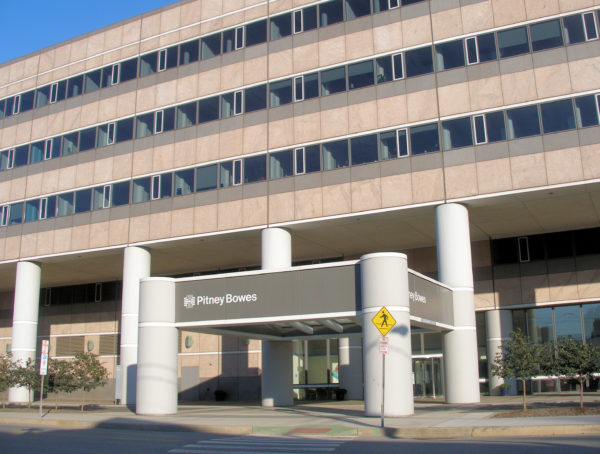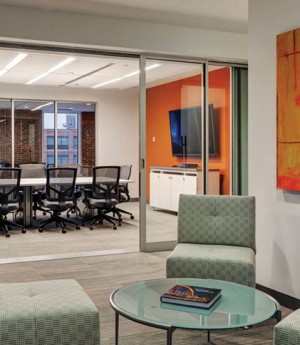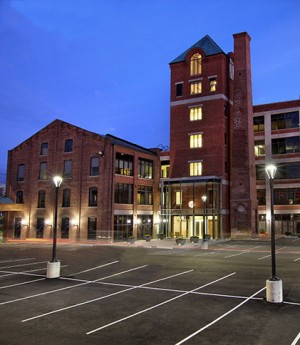Developers focus on new office designs for new generation of tenants

- The former Pitney Bowes global headquarters at 1 Elmcroft Road will be transformed into Silicon harbor by Stamford real estate developer Building and Land Technology.
Stamford”™s stock of old corporate headquarters and multi-thousand-square-foot office buildings are being redesigned to attract a new generation of commercial tenants, with a particular focus on technology and media companies.
“That”™s what we are seeing today, when you think about new economy type tenants, technology, marketing, advertising and IT firms, they are looking to be within that sort of mixed use ecosystem where they have great space, but they are also in a  great environment where they can get out and walk,” said  Ted Ferrarone, chief operating officer for the Stamford-based real estate development firm Building and Land Technology. “They are using the surrounding environment much more than a  traditional office tenant would.”
BLT is currently redeveloping the former 550,000-square-foot Pitney Bowes global headquarters at 1 Elmcroft Rd. into what will be known as Silicon Harbor. The redevelopment will focus on creating open spaces and large floor plans that have become known for increasing collaboration and productivity among employees as well as with a quality of living that have become commonplace in cutting-edge west coast offices.
Purchased earlier this year for $38.5 million, Ferrarone said the company envisions Silicon Harbor as a perfect fit for new economy tenants offering an environment of live, work and play amenities within the company”™s $3.5 billion Harbor Point development that has brought new commercial and residential space to the city over the past five years, including 2,300 apartments, several hundred thousand square feet of office space and more than 30 retailers.
The combination of community and commerce are exactly what new economy tenants are looking for said Jim Phillips, a portfolio manager with BLT.
“As we were out in the marketplace talking to technology tenants, we found there was a real resonance here where people drew a lot of parallels to what is going on out in Silicon Valley,” he said. Â “When you look at what we have here in Stamford, it actually shares all those characteristics ”” great transportation, great housing and nightlife. The thing that is unique here is we have a really active waterfront, which no place else in Connecticut has. When you couple that with being right off [Interstate] 95 and by the Stamford train station, it is a great package.”
According to a Q3 2015 office market report from real estate firm CBRE”™s Fairfield/Westchester office, it is the small and mid-size firms that are filling the city”™s empty buildings, with small to mid-sized tenants under 10,000 square feet continuing to dominate recent leasing activity, accounting for 85% of the total transactions in Q3 2015.
The same report also states that vacancy rates for Stamford”™s Central Business District in Q3 were at 24.1 percent, a frequently cited statistic, but one that is not an entirely accurate reflection of the demand from tenants who are seeking more modern and cost efficient spaces, Ferrarone said.

- The interior of 700 Canal Street was designed to meet the style of open floor plans and collaborative work spaces that have become popular in west coast offices.
Vacancies tend to be concentrated in either former world headquarter buildings that are being reinvented or they are in buildings that are functionally obsolete, he said.
Far from transportation and mixed commercial and residential hubs, these building are not what modern tenants are looking for and will have to be “re-imagined” to be successful, according to Ferrarone.
Owned by ClearRock Properties of Manhattan in partnership with Gottesman Real Estate Partners and Mountain Development Corp., both of New Jersey, 700 Canal St is the perfect example of commercial redevelopment that is needed to attract new economy tenants, said Mike McCall, vice president in CBRE”™s Fairfield/Westchester County office which currently manage the leasing and marketing of the building.
Following a $4 million top-to-bottom makeover, the 90,000-square foot building features a loft style design with exposed brick, high ceilings, and a new glass lobby.
McCall reports the the new design has been a hit and is rapidly becoming a standard for commercial redevelopment projects across the city.
“You can certainly tell from the result ownership has had for the 24 months that it speaks volumes about the demand for this type of space,” McCall said. “Certain buildings lend themselves to this kind of redevelopment, but now we are seeing other landlords construct pre-built units with this loft style.”
McCall has also noticed a growing trend towards luxury services such as a building-wide concierge as part of the new focus on tech- and digital-based companies.
From having your car washed and the delivery of groceries and dry cleaning to event planning  and catering services, McCall sees these services increasingly becoming standard if Stamford is to continue to rebrand itself as a destination for cutting-edge industries.
“This is something we have seen in larger more sophisticated markets in the country that have been very attractive for hi-end users.” he said “The existing landlords just need to get more creative with these traditional office buildings to adjust to the times.”
“Tenants want that cool, hip office environment to attract the best and brightest employees.”
